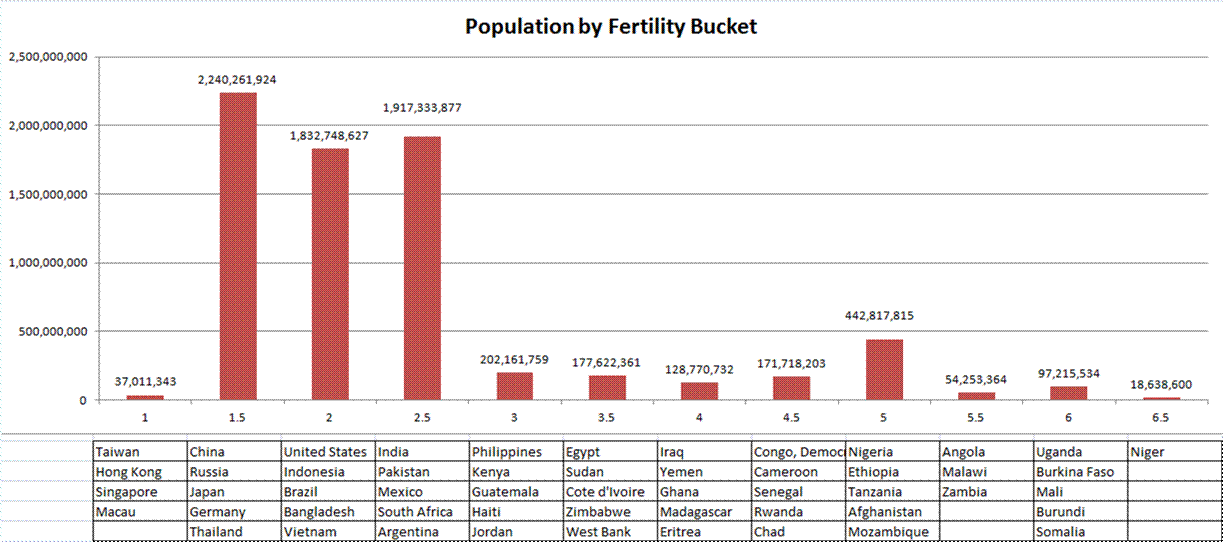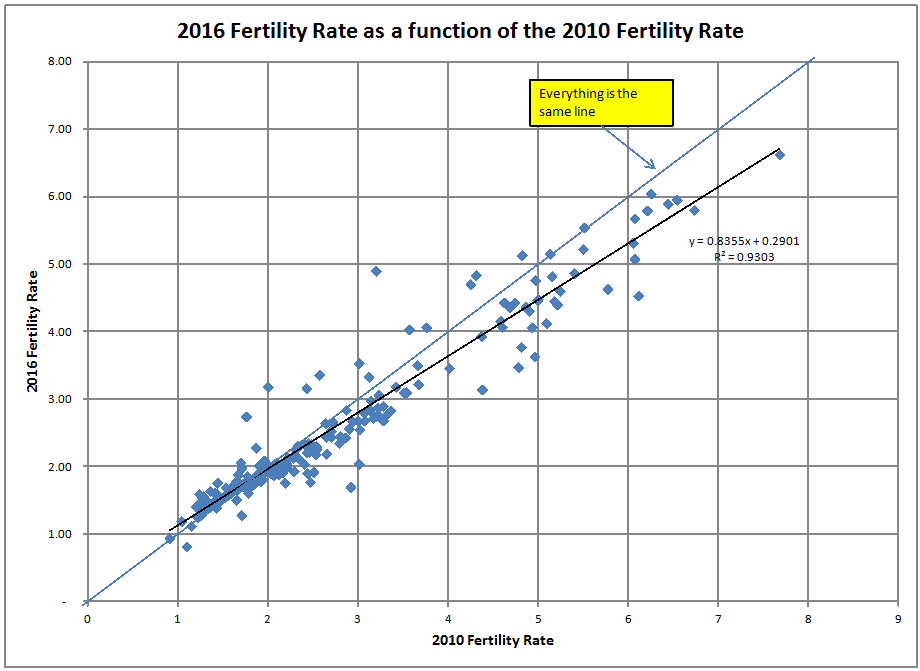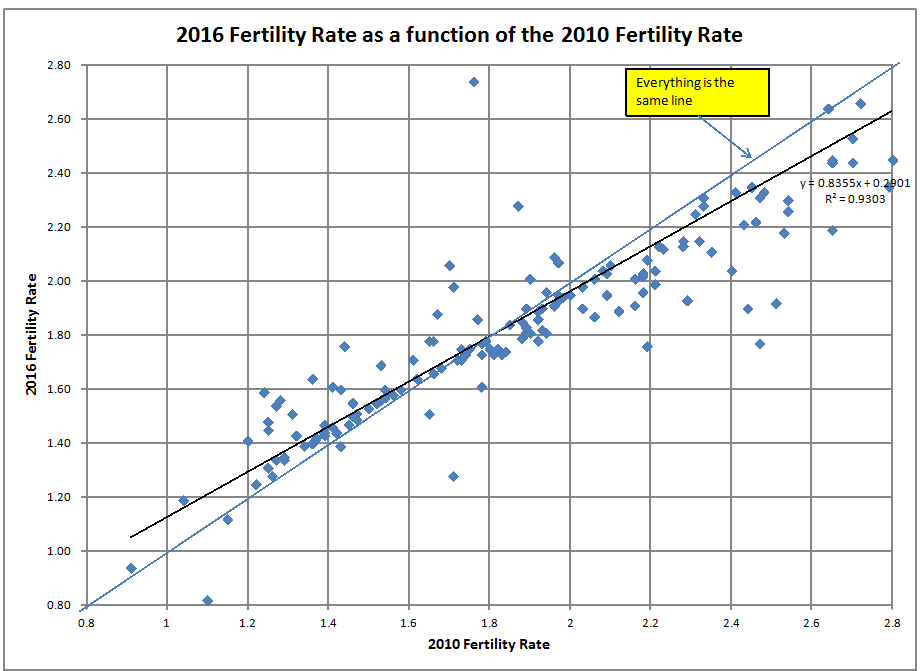
========================
I write about this every now and then, because human fertility is falling faster then most demographers expect. Using the CIA Factbook for data, the present total fertility rate for the world is 2.407 births per woman that survives childbearing. That is down from 2.425 in 2014, 2.467 in 2012, and 2.489 in 2010.? At this rate, the world will be at replacement rate (2.1), somewhere between 2035 and 2040. That?s a lot earlier than most expect, and it makes me suggest that global population will top out somewhat below 9?Billion in 2050, lower and earlier than most expect.
Have a look at the Total Fertility Rate by group in the graph above. The largest nations for each cell are listed below the graph. Note Asian nations to the left, and African nations to the right.
Africa is so small, that the high birth rates have little global impact. Also, AIDS consumes their population, as do wars, malnutrition, etc.
The Arab world is also slowing in population growth. When Saudi Arabia at?replacement rate (2.11), you can tell that the women are gaining the upper hand there, which is notable given the polygamy is permitted.
In the Developed world, who leads in fertility? Israel at 2.66. Next is France at 2.07 (Arabs), New Zealand at 2.03, Iceland at 2.01, Ireland at 1.98 (up considerably), UK at 1.89, Sweden at 1.88, and the US at 1.87, which is below replacement. The US?still grows from immigration, as does France.
Most of the above is a quick update of my prior pieces, which have some additional crunchy insights. ?When I look at the new data, I wonder if developed nations might not finally be waking up to the birth dearth. ?Take a look at this graph:
Now, the bottom left is a little crammed. ?What if I expand it?
I did the second graph in order to make the point that nations with fertility below 1.76 in 2010 tended to increase their fertility, while those above 1.76 tended to decrease it. ?Not that you should trust any statistical analysis, but if you could, this is statistically significant at a level well above 99%. ?(Note: this is an ordinary least squares regression. ?Every “nation” is weighted equally. ?If I get asked nicely, I could do a weighted least squares regression which gives heavy weight to China, India and the US, and less weight to Somalia, the West Bank, and Tonga. ?I don’t think the result would change much.)
I’m chuckling a little bit as I write this, because this is an interesting result, and one that I never thought I would be writing when I started this project. ?Interesting, huh? ?My guess is that there is a limit to how much you can get people to reduce family sizes before they begin to question the idea. ?Older parents may say, “What was that all about?” but children are usually fun and cute when they are little if they are reasonably disciplined.
One final note: I’ve been running into a lot of demographic articles of late, but this was the one that got me to write this:?The World’s Most Populous Country Is Turning Gray. ?The barbaric “One Child Policy” of China is having its impact; demography is often destiny. ?That said, over the last six years China’s total fertility rate has moved from 1.54 to 1.60.
As it says in the article:
Births in 2016 reached 17.86 million, the most since 2000, rising by 1.91 million from 2015, the National Health and Family Planning Commission said this month. That still falls short of the official projection. Last June, the ministry estimated there would be an increase of 4 million new births every year until 2020. China will continue to implement the two-child policy to promote a balanced population, the plan said.
Fertility doesn’t turn on a dime. ?When women conclude that the rewards of society (money, power, approval of peers) go to those with fewer children, that’s a tough cultural idea to overcome. ?I would conclude that it will take a lot longer than a single five-year plan to turn around birthrates in China… if they can be turned around at all. ?All across Asia, marriages happen at lesser rates, happen later, and produce fewer children. ?China is one of the more notable examples.
PS — Picky note: the two-child policy in China is only available to a husband and wife where at least one is an “only child.” ?It won’t create a balanced population near replacement rate, as everyone else must have only one child (with exceptions).



Interest human life begins to decline in 2050 is the same year that Ray Kurzweil predicts self-aware robots/AI.
Fascinating. I’ve been pessimistic about population growth and the fate of the planet and the humans that live on it, but it’s heartening to see that there will be a leveling off in a few decades. At least according to projections.
Hi, it resonates with an article from the World in 2017 from the economist.
http://www.theworldin.com/edition/2017/article/12583/gates
Fewer births now, but those born “too many” 20 years ago are now becoming young adults.
And thus:
“Demography, urbanisation and economic change are pushing people out of poor and middle-income countries and into the rich nations that so dislike them.
Because people tend to migrate in young adulthood, the size of that group determines the pool of potential migrants. It is enormous and growing. In 2000 sub-Saharan Africa had about 48m people aged between 25 and 29, according to the United Nations. In 2015 it had 75m, and by 2030 it will probably have 113m. Some countries with middling or low birth rates today, such as India and Turkey, had high birth rates 20 years ago, and now have lots of young adults as a result. Every month 1m Indians turn 18. “
It seems like you are empirically deriving the mean-reversion central tendency. I suspect that a weighted average will be pretty close, but could you pretty-please do a set of population-weighted regressions? And then (for fun) a per-capita-GDP-weighted regression? That one may be radically different. Or maybe not: oil-rich nations with male-dominated cultures have high per-capita GDPs and also high fertility. Still, it would be an interesting test.
I will get to this. Thanks for asking.
The problem accepted numbers is the existential issue of rising drug resistency.
The 23 year worldwide life expectancy extension from 48 years in 1950 to 71 today has been due to antibiotics. With the biorisk from 100 percent drug-resistant ?mcr-1? and other pathogens, life expectancy is expected to trend back to 50 years between 2015 and 2050. http://www.breitbart.com/california/2017/02/01/biorisk-death-china-california-first-case-100-drug-resistant-infection-los-angeles/
This is a real problem, no doubt. I don’t think it will get that big. We have not had to go “all out” on a systemic health threat. We don’t even know what we could do to fight it if pressed.
Also, there are a variety of non-antibiotic therapies being developed now to deal with drug resistance.
“Africa is so small, that the high birth rates have little global impact. Also, AIDS consumes their population, as do wars, malnutrition, etc.” I have read that Africa’s population by 2100 is expected to hit four billion. It is hard to imagine the continent supporting so many people so they will surely attempt to migrate, which will have a very significant global impact.
Nick de Peyster
http://undervaluedstocks.info/
Birth rates are falling fastest in Africa.